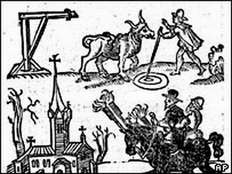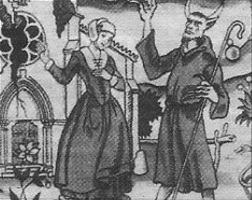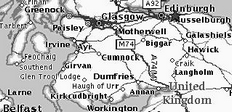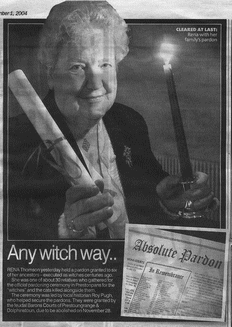
81 Scottish “Witches” Pardoned
by Hans Sherrer
For Justice:Denied magazine (December 2004)
Halloween 2004 was very special for 81 Scots. Convicted of being witches and executed in the 16th and 17th centuries, their innocence was publicly declared during an October 31st ceremony in Scotland’s Prestonpans township. The ceremony followed Baron Gordon Prestoungrange’s grant of posthumous pardons to the 81 people on July 27, 2004. 1
Witchcraft was made a capital offense under Scotland’s Witchcraft Act of 1563 (also known as Mary’s Law) that was given royal assent by Mary, Queen of Scots. 2 (That same year, 1563, Queen Elizabeth I assented to England’s adoption of a copycat Witchcraft act.)] Mary’s Law defined witchcraft as “conjuration or sorcery,” and a witch was a person considered to have supernatural powers granted by Satan in exchange for their soul.

The 81 pardoned people were convicted of being witches in Prestonpans during a period of time that Scottish historian Roy Pugh has described as a “mini-holocaust.” 3 From 1563 to 1727 as many as 4,500 Scots - 80% women - were lawfully convicted of witchcraft and executed. That is an average of more than two innocent people in Scotland being convicted of a capital crime every month for 164 years.
Woodcut depicting John Fian, a schoolmaster whom was convicted of witchcraft in 1590 and burned to death in Edinburgh, Scotland. Fian was one of the 81 people pardoned by Baron Gordon Prestoungrange on July 27, 2004. (Glasgow University Library - AP Photo)
Many people were identified as witches by an informant who offered ‘spectral evidence’ against the accused person. Those prosecution witnesses claimed to have “’felt’ the presence of evil ‘spirits’ or ‘heard’ spirit ‘voices’” while in the presence of the accused person. 4 The ethereal nature of ‘spectral evidence’ made it difficult for a person to disprove an accusation of being a witch, since there was no way to cross-examine the alleged ‘spirit’ concerned. 5 Additional prosecution support for an accusation of witchcraft was typically as insubstantial as a person’s brewing of homemade remedies, owning a black cat, or living alone. 6
A suspected witch had no refuge, since in a counterpart to today’s conspiracy laws, under Mary’s Law anyone who assisted him or her was subject to being accused of witchcraft based on guilt by association. 7

Woman being courted by the Devil to exchange her soul for supernatural powers. (Scottish Sunday Express)
Witch hunting became a profession in 1603 after enactment of Scottish Statute 1603, 1 Jac. 1, c. 12, which authorized the appointment of “witchfinders” to ferret out or investigate an accused witch. 8 The 17th century counterpart of today’s “special prosecutor,” a witchfinder had broad investigative powers. One of their witch detection techniques was to prick a suspect “with pins until they found the ‘devil’s mark’” 9
The pardons by the Barons Court noted that after being identified by an informant or a witchfinder, a suspected witch’s examination was “conducted in an atmosphere of terror with total physical examination by witch prickers. Confessions were extracted by hideous torture .... Some would be dipped in the river or held under freezing water until they confessed. If by some lucky chance, they survived, they were considered innocent. Many old women died from drowning whilst undergoing such tortures. The use of lashes, witch bridles, irons and pilniewinks [thumbscrews] was widespread to extract confessions.” 10 A “witch’s bridle” was a diabolical medieval device designed to extract a confession from an obstinate suspected witch, by exhausting him or her from a lack of sleep. The Dictionary of Phrase and Fable (1898) described it as “an iron bridle or hoop bound across [the person’s] face with four prongs thrust into [their] mouth. The “bridle” was fastened behind to the wall by a chain in such a manner that the victim was unable to lie down.” 11 The accused witch was kept in that position until he or she either confessed or collapsed from exhaustion and had their face ripped off.
Although the precise figure is unknown, the confession rate under those circumstances was very much in the prosecution's favor. Convicted upon undefendable ‘spectral evidence’ and their coerced confession, the “witch” was then burnt at the stake.

However while Scots were told the witchcraft laws were helping to rid their country of evil elements, the truth was far more sinister. While researching his 2001 book, The Deil’s Ain (The Devil’s Own), Scottish historian Roy Pugh identified a single motive behind the ruthless hunting of innocent people who could plausibly be accused of being a witch, their barbaric treatment in being forced to falsely confess, and then their unimaginably painful death by being burned alive: “Controlling the population through religious fanaticism.” 12 When public authorities issued an order for a witch-hunt, the superstitious fears of a large segment of the population was unleashed - distracting them from real problems that plagued their lives. As Pugh described it:
Prestonpans, Scotland: The
Most Noble City in the World
Prestonpans is a city of about
7,000 people located in southeastern Scotland near Edinburgh. It
holds the unique distinction of being the only city in the world
that has not only publicly declared it was the site of many dozens
of innocent people being wrongly convicted and executed - but it
commemorates that egregious crime against humanity by holding a
public ceremony each year in honor of those unfortunate people. That
open and respectful admission that an inexcusable wrong was
committed against innocent people in Prestonpans by public
authorities, is in sharp contrast with the attitude of public
officials worldwide who take the ostrich approach of ignoring how
prevalent incidences of a wrongful conviction have been, and
continue to be within their sphere of authority. Prestonpans' annual
observance of the wrongful convictions of people as witches is
consistent with the Random-House Webster’s Unabridged
Dictionary’s definition of noble: “4. of an
exalted moral or mental character or excellence.; 5. admirable in
dignity of conception, manner of expression, execution, or
composition. 7. of an admirably high quality; notably superior.”
Consequently Prestonpans has distinguished itself as the noblest
city in the world.
Prestonpans is the starred city
near Edinburgh.

“The ingredient of the witch hunt included putting the fear of God into the population, encouraging hysteria, paranoia, hypocrisy, self-righteousness and prejudice – vital ingredients in a crusade which was based on superstition masquerading as Christian principles. The hapless victims of the witch-hunt – eight out of ten were women – became the scapegoats for all the ills which afflicted that predominately rural society, in which illness struck without warning and animals died suddenly and mysteriously. In my researches, I found a connection between the witch epidemics and the dearth of food which threatened survival. The witch-hunt was as much a mirror of a crisis of the intellect as it was the product of a harsh climate, periodic economic crisis and personal misfortune.
The [authorities] readily grasped the potential for propaganda. [They] saw that the ills of society could be blamed on those who had strayed from the faith or left the path of righteousness. [T]he leading lights in this crusade, were the ministers and landowners, the ‘better off’ minority of the time. In this, they were aided and abetted by the secular authorities ... to give these commissions some veneer of legality. ... These kangaroo courts allowed neither legal counsel for the accused, nor did they permit a jury. Witnesses – usually hostile and prejudiced – gave evidence to the commission, a process which did not allow cross-examination.
Witchcraft trials were legal insofar as suspects were indicted under the Witchcraft Act of 1563. Where I take issue with this is the manner in which the trials were conducted and the ludicrous evidence which was used to obtain a guilty verdict. The nonsense which passed as evidence was only surpassed by the ignorance, stupidity, superstition, self-righteousness and paranoia of those who were appointed to try their victims.” 13
The centuries long reign of terror against innocent people branded as a witch ended with Scotland’s Witchcraft Act of 1735. That Act banned the execution of a person for witchcraft, however it criminalized pretending to be a witch. Thus while Scotland’s last witchcraft execution was in 1727, witchcraft related prosecutions continued through the mid-20th century. The most recent prosecution, in 1944, resulted in Helen Duncan’s conviction of “pretending to be able to make spirits materialise.” 14 A campaign to overturn her conviction was denied in 2002.
Prior to the Witchcraft Act of 1735 a few brave souls spoke out against the prosecution, conviction and execution of people who were plainly innocent of committing a capital crime. Reginald Scott was one of those people. In 1584 Scott wrote The Discoveries of Witchcraft with “the goal of preventing the further persecution of people popularly believed to be witches. The declared purpose of his studies was ‘to expose the impostors on the one hand, and the credulity on the other that supported the belief in witchcraft’.” 15 The continued execution of convicted “witches” in Scotland for another 143 years indicates that although well intentioned, Scott’s book was ineffectual at affecting public policy.
Some people have scoffed at the July 2004 pardons. However the Barons Court has existed since 1189 - predating the signing of the Magna Carta in 1215 by several decades - and it had the de jure legal authority to issue the pardons. 16 Furthermore, it was imperative that the pardons were granted before November 28, 2004, when Baron Prestoungrange’s ancient feudal power of pardoning would be stripped by legislation that ended Scotland’s feudal system. The July 27, 2004 grant of Absolute Pardon states in part:
FINDS IN FACT:
1) THAT it appears that a gross miscarriage of justice was inflicted upon many persons convicted of ‘conjuration or sorcery’ within the jurisdiction of the Baron Courts of Prestoungrange and Dolphinstoun and executed for the same before the enactment of The Witchcraft Act 1735.
2) THAT before the enactment of The Witchcraft Act, 1735, thousands of people through out
Scotland and their cats, were executed for ‘conjuration or sorcery’ ... upon legally insufficient ‘spectral evidence’ under Scots Law.
3) THAT those persons condemned for witchcraft within the jurisdiction of the Baron Courts of Prestoungrange and Dolphinstoun were convicted on the basis of ‘spectral evidence’, that is to say, the ‘voices’ or actions of ‘spirits’ given as ‘evidence’ of the ‘guilt’ of the accused.
4) THAT this gave rise to a situation of waging private vendettas by accusing one’s enemies of witchcraft.
5) THAT all those persons and their cats were convicted of ‘conjuration or sorcery’ within the jurisdiction of the Baron Courts of Prestoungrange and Dolphinstoun and executed for the same were convicted on the basis of legally insufficient “spectral evidence” and were probably the victims of personal vendettas by personal enemies who alleged the commission of ‘Witchcraft’ solely as a means to getting rid of the accused.
Queen Elizabeth Requested to
Pardon 56 “Witches” Convicted of Treason
Baron Gordon Prestoungrange’s
pardoning authority did not extend to treason against the Crown. So
in the summer of 2004 he formally submitted a request to Queen
Elizabeth II that she issue pardons to 56 of the Prestonpanians he
absolutely pardoned for witchcraft, who were also convicted of
treason. The Baron wrote in his request to the Queen, “What
does seem clear is that the offences against the King (James I)
which led to their conviction for treason were concerned with
creating storms at sea between Scotland and Denmark in 1589 when
James and his proxy wife, Anne, attempted to sail to meet one
another. ... We humbly beseech that you may review the evidence and
grant your absolute pardon.” The Baron’s request was
based on the reasoning that since the conviction of the 56 people -
13 men and 43 women - for treason was predicated on their wrongful
conviction of using witchcraft to cause the storms, then they had
necessarily been wrongly convicted of treason. The Queen did not
summarily reject the Baron’s request. Quite to the contrary,
in a September 2004 letter the Queen informed Baron Prestoungrange
that she had given instructions to the Scottish Executive in
Edinburgh and the Home Office in England to examine his request. As
of January 2005 the Queen’s investigation continues. Source:
Queen Asks Ministers to Probe Executions, Derek Lamble and John
Skinner, Scottish Sunday Express, October 24, 2004.
1) THAT ‘spectral evidence’, consisting of the ‘voices’ or ‘actions’ of evil spirits, is impossible to prove or to disprove in a court of law; nor is it possible for the accused to cross-examine the ‘spirit’ concerned: One is convicted upon the very making of such charges without any possibility of offering a defence against such ‘spectral evidence’.
2) THAT at the least, the verdict of “Not Proven” should have been rendered in all cases and situation where those accused of witchcraft were convicted on the basis of legally insufficient ‘spectral evidence’.
3) THAT all those persons and their cats convicted of ‘conjuration or sorcery’ within the jurisdiction of the Baron Courts of Prestoungrange and Dolphinstoun and executed for the same were wrongly convicted upon the basis of “spectral evidence” legally insufficient under Scots law to sustain a conviction.
HELD:
1) The Baron Courts of Prestoungrange and Dolphinstoun rule that weightily and sufficient grounds of both fact and law exist for vacating the conviction of all those persons and their cats who were convicted of ‘conjuration or sorcery’ within the jurisdiction of the Baron Courts of Prestoungrange and Dolphinstoun and executed for the same before the enactment of The Witchcraft Act 1735: In all cases such convictions were based upon ‘spectral evidence’ legally insufficient under Scots law to sustain a conviction. In all such cases the verdict of “Not Proven” ought to have been rendered by the Baron Courts of the day.
2) Accordingly, the Baron Courts of Prestoungrange and Dolphinstoun grant an Absolute Pardon to those persons convicted of ‘conjuration or sorcery’ within their jurisdiction before the enactment of The Witchcraft Act 1735 as well as to the cats concerned.
3) Furthermore, the Baron Courts order that this most unfortunate miscarriage of justice inflicted upon such persons and their cats be remembered:
(i) in murals to be painted in the baronies depicting their plight;
(ii) by an historical record being published that both recounts their alleged crimes and punishments and records such Absolute Pardon; and that,
(iii) the tragic events involved be re-enacted each year on Hallow-e’en and from time to time as a living reminder of this earlier process of justice in Scotland. 17
It will be noted that Baron Prestoungrange magnanimously pardoned the cats burned alive with their human companion.
Upwards of thirty descendants and namesakes of the pardoned people attended the October 31, 2004 ceremony in Prestonpans during which the innocence of the condemned witches was publicly recognized. The ceremony also marked Prestonpans’ first Witches’ Remembrance Day, which will henceforth be held each October 31st in commemoration of the wrongly convicted people. A township spokesperson said, “There were some concerns that we’ve got the ceremony on Halloween, but we couldn’t have a witches remembrance in the middle of March. It has a serious purpose, we’re respecting these unfortunate individuals.” Historian Pugh, whose book The Deil’s Ain (Harlaw Heritage 2001) inspired interest in re-opening the cases of the people who were pardoned, said in part during the ceremony:
“It is too late to right the wrongs of a previous age. This modest ceremony may go some way towards a symbolical recognition of those countless victims of the witch-hunt who were cruelly persecuted. I invite those present – the possible descendants or namesakes of some of the 81 victims in Prestonpans – to lay a floral tribute at the Memorial which commemorates the names of those who were judicially executed.” 18

Rena Thomson holding a pardon granted to six of her ancestors wrongly convicted of being witches and executed.
Scottish Professor Believes
the Pardoned Prestonpanians were Witches!
Dr. Peter Maxwell-Stewart, a
lecturer at Scotland’s University of St. Andrews, is among the
critics of Baron Prestoungrange’s pardons. In the Scottish
Sunday Express (October 24, 2004) he was quoted as saying,
“There’s a high likelihood the people convicted were
guilty.” Thus Dr. Maxwell-Stewart expressed his belief in,
among other things, that the 56 Prestonpanians convicted of treason
against King James I had used witchcraft to cause Atlantic Ocean
storms in 1589. It might be enlightening for Dr. Maxwell-Stewart to
consider that if he had lived in Scotland 400 years ago, he might
have experienced being dragged from his home after a witchcraft
accusation, subject to all manners of torture before giving a
coerced confession, and then having his flesh burned from his body
while was he was still alive as his screams were muted by an iron
mouth piece. Then his ancestors could have experienced the poetic
justice of having some academic in 2004 pronounce his pardon of
witchcraft as farcical because he was likely guilty. With all due
respect to Dr. Maxwell-Stewart, the plain and simple reality he is
overlooking is the “high likelihood the people convicted”
of witchcraft in Prestonpans and executed were no different than
himself. He is likewise overlooking that if the roles were reversed,
he too would have fallen prey to prosecutors and judges running
amuck. Queen Asks Ministers to Probe Executions, Derek Lamble and
John Skinner, Scottish Sunday Express, October 24, 2004.
Eighty-One People Pardoned on July 27, 2004
Name Year of Execution
|
Margaret Aitchesoun |
1590 |
|
Masle Aitchesoun |
1590 |
|
Agnes Aird |
1661 |
|
Marjorie Andersone |
1678 |
|
Margaret Auchinmoutie |
1661 |
|
Marioun Ballzie (Baillie) |
1590 |
|
Christian Blaikie |
1661 |
|
Meg Bogtoun |
1590 |
|
Janet Boyd |
1628 |
|
Bessie Broune (Brown) |
1590 |
|
Thomas Brounhill (Brownhill) |
1590 |
|
Wife of Thomas Brounhill |
1590 |
|
Duncan Buchquhannan |
1590 |
|
Margaret Butter |
1661 |
|
Martha Butter |
1659 |
|
Jonett Campbell |
1590 |
|
Elspeth Cheuslie |
1679 |
|
Thomas Cockburn |
1590 |
|
Marioun Congilton |
1590 |
|
Bessie Cowane |
1590 |
|
Beatrix Cuthbertson |
1628 |
|
Janet Darlig |
1628 |
|
Agnes Dempstar |
1628 |
|
Gelie Duncan |
1591 |
|
Catherine Duncane |
1590 |
|
Thomas Fean |
1591 |
|
John Flan or Flene |
1590 |
|
Jonett Gall |
1590 |
|
Malie Geddie |
1590 |
|
Helen Gibesone (Gibson) |
1661 |
|
Johnne Gordon |
1590 |
|
Catherene Gray |
1590 |
|
Jonnett Gray |
1661 |
|
Robert Griersoune |
1591 |
|
Issobell Griersoune |
1607 |
|
Issobell Gylloun |
1590 |
|
Margaret Hall |
1661 |
|
Agnes Kelly |
1678 |
|
Cristian Kerington |
1590 |
|
Helene Lauder |
1590 |
|
Issobell Lauder |
1590 |
|
Agnes Liddell |
1628 |
|
Katherine Liddell |
1678 |
|
Jonett Logan |
1590 |
|
Ewfame McCalzean |
1590 |
|
Euphernia McLean |
1590 |
|
Catherine McGill |
1590 |
|
Gilbert McGill |
1590 |
|
Johnne McGill |
1590 |
|
Barbara Mathie |
1628 |
|
Wife of George Moitis |
1590 |
|
Wife of Nichol Murray |
1590 |
|
Ane Nairn |
1591 |
|
Jonett Nicolsoun |
1590 |
|
Marioun Nicolsoun |
1590 |
|
Margaret Oliver |
1628 |
|
Marie Patersoune |
1590 |
|
wife Portar of Seton |
1590 |
|
Helen Quhyte (White) |
1590 |
|
Alexander Quhytelaw (Whitelaw) |
1590 |
|
Wife of John Ramsey |
1590 |
|
Marion Ranking |
1590 |
|
Janet Reid |
1628 |
|
Bessie Riddell |
1628 |
|
Margaret Ridpeth |
1628 |
|
Donald Robinson |
1590 |
|
Anny Rycheson |
1590 |
|
Daughters of Agnes Sampsoun |
1590 |
|
Agnes Sampsoun |
1590 |
|
Marioune Schaw |
1590 |
|
Ane Simson |
1591 |
|
Wife of Smythe |
1590 |
|
Elizabeth Steven |
1629 |
|
Jonett Straitton |
1590 |
|
Janet Strauchane (Strachan) |
1628 |
|
Margrett Thomson |
1590 |
|
Bessie Thomsoune |
1590 |
|
Katherine Wallace |
1590 |
|
Charles Wat |
1591 |
|
Bessie Wrycht (Wright) |
1590 |
|
Margaret Young |
1628 |
Endnotes:
1 Absolute Pardon, at, http://www.prestoungrange.org/core-files/archive/abspardon.pdf (last visited November 26, 2004) ] Sixty-eight were women and 13 were men.
2 Address by Roy Pugh, October 31, 2004, First Remembrance of Prestonpans 81 Witches, at, http://www.prestoungrange.org/core-files/archive/RoyPugh.pdf (last visited November 26, 2004
3 Witches in the Clear after 400 Years, Baron Courts of Prestoungrange & Dolphinstoun website, October 29, 2004, http://www.prestoungrange.org/prestoungrange/html/news/show_news.asp (last visited November 26, 2004).
4 Judgement and Declarator, Barons Courts of Prestoungrange & Dolphinstoun, Trinity Session: Elizabeth II. 53. 2004, July - November, ¶ 7.A., at, http://www.prestoungrange.org/core-files/archive/trinity_session/09_1753_impost_on_fowlers_at_2d_per_pint.pdf (last visited November 26, 2004).
5 Id. At ¶ 7.B.
6 81 Witches, Executed with Cats Centuries Ago, to be Pardoned, Seattle Post-Intelligencer, October 30, 2004, p. A4.
7 Judgement and Declarator, supra at ¶ 5.B.
8 Id. at ¶ 5.
9 Id. at ¶ 5.A.
10 Id. at ¶ 4.D. (Pilniewinks (thumbscrews) were fitted to the victim’s thumbs and then tightened until the thumbs were crushed. They were also called ‘Thumbikins’.)
11 “Waking a Witch,” Dictionary of Phrase and Fable, 1898, E Cobham Brewer, at http://www.bartleby.com/81/17223.html (last visited November 26, 2004).
12 Address by Roy Pugh, supra.
13 Id.
14 Queen Asks Ministers to Probe Executions, Derek Lamble and John Skinner, Scottish Sunday Express, October 24, 2004.
15 Judgement and Declarator, supra at ¶ 6.
16 The Baron’s Court’s website is, http://www.prestoungrange.org/prestoungrange/index.html (last visited November 26, 2004).
17 Judgement and Declarator, supra
18 Address by Roy Pugh, supra.